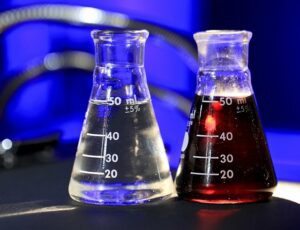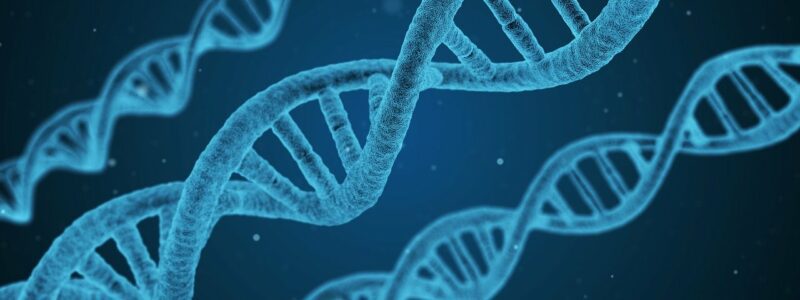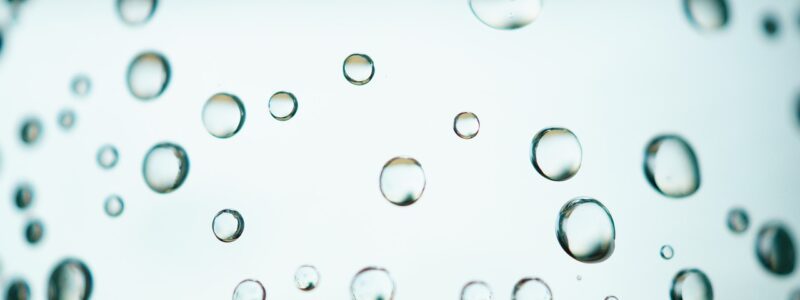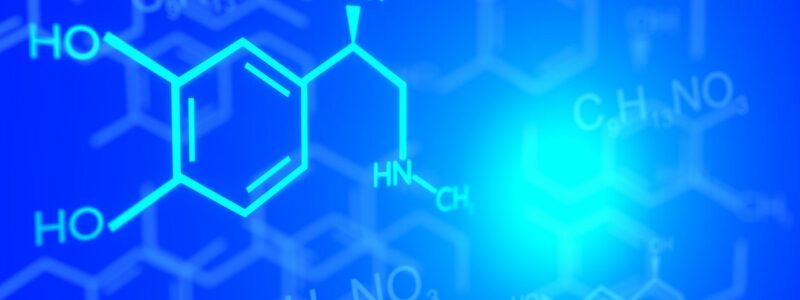Prebiotic Soup
The prebiotic soup is the mixture of chemicals in the ancient Earth which produced the first life.
It is commonly known throughout our culture, so much so that it was a theme of a Star Trek episode. In this episode, Captain Picard is taken back to ancient Earth to witness the prebiotic soup from which all life came.
Generations of high school students have been taught the prebiotic soup is the organic chemical mixture of common chemical. Energy in the form of light and heat produce chemical reactions in the soup that with enough time produced the earliest life form.
The organic chemicals became more concentrated during a dry season allowing for increased numbers of chemical reactions to occur. It is from this earliest life that the rest of creation is thought to arise.
Modern science now has considerable doubt whether there was a prebiotic soup behind all life on Earth – or even any life. These doubts are from a re-examination of the facts concerning early life formation scenarios.
The Ingredients of Life
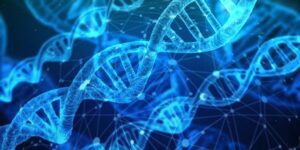
Image by Gerd Altmann from Pixabay
Modern biochemistry understands the chemistry of life fairly well. Over the course of centuries and with countless clever experiments, scientists have unraveled the chemical structure of human DNA. They have also unraveled the DNA of many other plant and animal species.
They have found that all life shares common characteristics from bacteria to humans. All life is composed of organic molecules. These molecules include nucleic acids, sugars, proteins, and fats.
Of the 112 naturally occurring elements, only carbon has the chemical characteristics to enable complex life. Silicon is the only other elements with similar chemistry. However, silicon cannot produce a tremendous variety of chemicals like carbon.
The chemical bond between two silicon atoms is much weaker than between two carbon atoms. Protein analogs made from silicon are only about one-hundred amino acids long. Longer chains become unstable and spontaneously degrade.
These properties make silicon useless for the production of life.
Prebiotic Soup in the Lab
Decades of science books show conditions that are thought to produce life chemicals. Several of the twenty life amino acids have been produced in simulated prebiotic soup. Additionally, all the nucleotide bases (adenine, guanine, cytosine, and uracil) are made in similar experiments.
However, amino acids are a different matter. Several amino acids have yet to be made in this manner including arginine, lysine, and histidine, as well as enzymatic cofactors.
A complicating factor in any prebiotic soup scenario is that many of the amino acids cannot be made as a group. This is because condition that enable some to be produced will destroy others. Two nucleotide bases (adenine and guanine) require freezing conditions for their synthesis. However, two other nucleotide bases (cytosine and uracil) demand boiling temperatures.
These different temperatures make the production of all four nucleotide pairs difficult at best.
Prebiotic Soup from Space Debris

Image by Fabien Huck from Pixabay
Scientists have also considered the production of prebiotic soup from extraterrestrial chemicals. Some meteors are known to contain various organic chemicals. Some have argued these chemicals could have been deposited in water enabling soup formation.
The Murchison meteorite even contained several nucleotide bases – but in very low concentrations.
Ongoing analysis of these meteorites has dampened initial enthusiasm.
These meteorites have organic compounds at vanishingly small concentrations. These concentrations are much lower than in origin of life experiments described above. For example, the Murchison meteorite contained amino acids at concentrations of less than fifteen parts per million of the amino acids found in proteins.
The Tagish Lake meteorite was recovered after falling into a frozen lake in northern Canada. Scientists believe that falling in a cold lake in a remote area might reduce Earth contamination of the meteorite.
Scientists analyzed this meteorite and found it contained from 20 to 1000 times fewer amino acids per volume than did the Murchison meteorite. Furthermore, meteorites can absorb contaminants from the Earth’s atmosphere even before they hit the ground.
Naturalist scientists counter that the sheer volume of meteorite impacts on ancient Earth might have brought in significant amounts of organic material.
Contributions from Comets
The Murchison and Tagish meteorites were made largely of carbon. Comets are described as “dirty snowballs” as they are made largely of ice. Comet collisions with ancient Earth were much more common on the ancient Earth than they are today.
Comets are thought to have contributed about one hundred times more carbon as meteorites. No amino acids have been found in comets although organic compounds have been located.
The amount of organic materials carried by a comet is still very small. Carbon monoxide, carbon dioxide, and water make up about 99 percent of a comet’s mass. Other carbon compounds contribute less than one percent of the mass.
Hydrogen Cyanide
The discovery of hydrogen cyanide in comets was exciting for the origin of life scientists. Under laboratory conditions, hydrogen cyanide can interact with organic molecules to produce amino acids and nucleotides.
However, when comets enter through the Earth’s atmosphere, the intense heating of the comet changes the hydrogen cyanide to formic acid. This is a dead-end chemical for the production of life molecules.
Interplanetary Dust
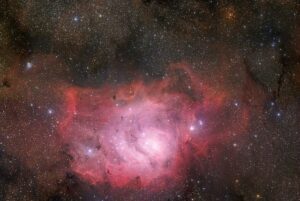
Image by WikiImages from Pixabay
Interestingly, the greatest amount of organic material arriving on Earth does not come from comets to meteorites. Interstellar dust and granules of material over time dump more than one hundred times as much carbon as comets. Also, the interstellar dust contributes about 40,000 as much carbon as meteorites.
Astrobiologists have been studying interstellar dust in nebulae and other sources. About 140 organic compounds such as alcohols, aldehydes, ketones, and some simple carbon rings have been located. The lack of amino acids other than the most simple type (glycine) speaks against this as a source of prebiotic soup chemicals.
Other scientists try to duplicate interstellar conditions to determine whether organic chemicals could be formed. One team gave radiation to an ice film made from water, methanol, ammonia, and hydrogen cyanide at -433 degrees F. This cold temperature was used to approximate the frigid conditions of interstellar space.
These scientists were able to isolate 16 amino acids; only six of these were biologically important. They suggest these might have been used in any prebiotic soup.
Interstellar Space Conditions
Enthusiasm concerning these experiments has subsided. Astrobiologists tested the stability of amino acids under ultraviolet light which can be substantial in space. They determined that “amino acids are highly susceptible to UV photodestruction even under exposure to UV photons of relatively low energy.”
This means that interstellar dust would be sterilized by the ultraviolet light in space. The surface of larger objects such as asteroids, comets, and meteors would also be sterilized.
The scientists noted, “amino acids have not been detected (in interstellar and interplanetary grains) because they are destroyed before they can accumulate in the gas phase.” Even though they can be made with in space, they are rapidly destroyed by the conditions there.
Organic Chemicals Lost in Space
Other biology scientists such as Curt Mileikowsky confirmed the destruction of amino acids and other organic chemicals in interstellar space from ultraviolet light. Interstellar radiation permeates up to thirty-nine inches of solid material in both meteorites and comets. All organic material on the surface of comets and meteors would be destroyed by this radiation.
Another problem is the demonstration that these chemicals would be destroyed by heat upon entering the Earth’s atmosphere. Such grains would be heated to over 1000 degrees F which is high enough to incinerate all amino acids.
Out of This World
Carl Sagan and others attempted to determine the actual amount of carbon compounds that could have hit earth 4.4 to 3 billion years ago. They found initially about a million tons per year could have layered the Earth. However, only about 4000 tons per year would be received toward the end of this time.
They estimated that about 20 tons of organic molecules arrived every year 4.4 billion years ago. This gradually declined over time until only 20 pounds arrived every year 3 billion years ago.
Scientists derived the best estimate of the amount of biologically important organic chemicals during this time. Most of the organic chemicals deposited on earth are not biologically important. They found that a little less than 0.02 ounces of amino acids would be delivered to earth each year.
This is about a gram of biologically important molecules per year sprinkled on the Earth’s oceans. Many of these chemicals would be quickly destroyed by the heat present on the early Earth. The concentration of organic molecules in earth’s ocean could gradually accumulate. However, it would only produce less than a hundredth of a quadrillionth of a gram per milliliter. This is far too little to contribute to life formation.
Existence of a Prebiotic Soup Comes into Question
Further research by astrobiologists might produce a little more or a little less organic molecules delivered to earth.
The problem needs to be put into perspective. Even the purest drinking water on Earth has a concentration of amino acids that is a hundred million times greater than this prebiotic soup.
In summary, modern origin of life scientists believe that extra-terrestrial sources of prebiotic compounds almost certainly had no meaningful contributions to life chemicals on Earth.
Earth’s Atmosphere as Another Source of Prebiotic Soup

Premordial soup did not come from chemical reactions in the atmosphere.
Origin of life scientists are discouraged regarding the possibility of extraterrestrial sources.
However, some have suggested atmospheric sources or organic molecules.
High school students have learned about the experiments of Stanley Miller for decades. In these experiments, early atmospheric conditions were simulated in a laboratory experiment. Many organic compounds were subsequently produced in this experiment.
Students have been taught that such experiments “prove” how life chemicals could be produced on early Earth.
These scientists postulated a reducing atmosphere consisting of hydrogen, methane, ammonia and water vapor. However, the early Earth’s atmosphere now is thought to be neutral consisting of nitrogen, carbon dioxide, carbon monoxide, and water.
Life molecules cannot be manufactured in a neutral or oxidizing atmospheric environment. Also, any hydrogen that would be present in any reducing atmosphere would quickly escape the Earth due to its low weight. It would likely be of little practical importance in the manufacture of organic chemicals.
All early life experiments using electrical discharge and a reducing atmosphere are not relevant to the early Earth. These are the ones shown in nearly every high school biology text promoting the concept of a prebiotic soup.
Volcanoes as a Source of Organic Molecules

Image by Free-Photos from Pixabay
Some origin of life scientists suggests early volcanoes might be important in the production of organic chemicals.
This is due to the insufficient production of a significant amount of organic chemicals in any prebiotic ocean soup or in the atmosphere.
Volcanoes today produce large amounts of carbon dioxide, water vapor, and sulfur dioxide. They note this oxidizing mixture cannot produce life chemicals. However, they suggest early earth volcanoes might have produced different compounds. There is little to no evidence for this conjecture.
Ocean Vents as a Source of Organic Molecules
Origin of life scientists have based some hope on the production of organic molecules in ocean vents.
There are many deep-sea hydrothermal vents throughout the oceans. These vents are the only place with hydrogen and oxygen-free chemical environments for production or organic molecules
Laboratory experiments with a hot environment simulating an ocean vent indicate that amino acids, peptides, and other life chemicals can be produced there.
Stanley Miller has demonstrated that the very high temperatures of ocean vents cause degradation of amino acids and sugars. Miller now concludes that ocean vents that produced organic compounds would also result in their degradation. This means they are of no practical important in production of prebiotic soup organic life chemicals.
Researchers at Penn State and SUNY showed ammonia was also produced in ocean vents. Ammonia was not present on early Earth and could not contribute to life chemical production.
All ocean water passes through ocean vents once every 10 million years on average. The density of these vents was much greater on early Earth and the circulation time was reduced. This reduced circulation time leads to the destruction of any organic compounds due to the intense heat.
Did Any Prebiotic Chemicals Exist on Ancient Earth
The inability to produce organic chemicals in early life experiments leads scientists to question whether any were available on ancient Earth. It has always been a tenant of early life scientists that a prebiotic soup was present. However, this recently has been brought into question.
There are ways to determine whether ancient carbon came from life or from simple organic chemicals. An ancient prebiotic soup would produce carbon from simple organic molecules. If there was no ancient prebiotic soup, then carbon would be from once living organisms.
The decay of once-living organisms shows a lower ratio of carbon 14 to carbon 12 than carbon from inorganic substances.
The measurement of carbon 13 to carbon 12 determines whether any carbon was produced from living things.
The results of these experiments is that all the carbon from ancient earth come from once-living things.
This finding destroys the primordial soup hypothesis. As Hubert Yockey notes,
The significance of the isotopic enhancement of carbon-12 in the very old kerogen in the Isua rocks in Greenland is that there never was a primordial soup and that, nevertheless, living matter must have existed abundantly on Earth before 3.8 billion years ago.
Similar to carbon, the ratio of nitrogen 15 to nitrogen 14 can indicate production from living or non-living reactions. The results show that all ancient carbon came from living things and not from prebiotic chemicals.
Finally, laboratory experiments show that amino acids require the presence of ammonia to occur naturally. Experiments have shown the early Earth atmosphere would not have enough ammonia. This means any prebiotic soup could not have produced amino acids.
This means there simply was no prebiotic soup on ancient Earth.
Conclusion
The most recent experiments in many origin of earth laboratories show that there was no prebiotic soup on ancient earth.
This is despite being present in every high school biology textbook.
Scientists are unable to find a means for the production of life chemicals naturally without life. This has not been for lack of wanting to find such a mechanism. Research has been ongoing for the past century without any success.
The reasonable person might surmise life chemicals were not designs by blind chance in a natural environment. Instead, they were intelligently designed for life on earth. The Biblical narrative is again confirmed.

